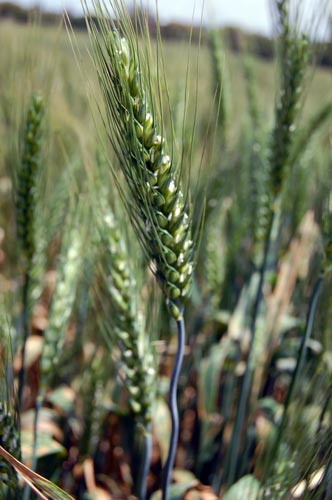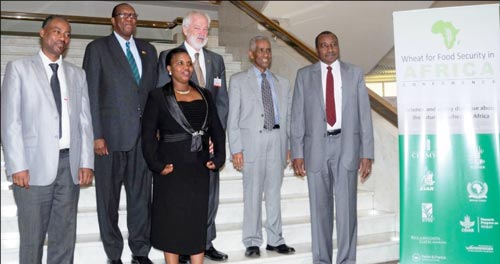 It was another exhausting, but productive day at the Wheat for Food Security in Africa conference at Addis Ababa, culminating in a wonderful evening of traditional dancing and the Injera cuisine so typical of Ethiopia. In case you missed any of our live tweeting during the day (#W4A), here is a brief roundup of the main events. It would be impossible to describe everything that happened in one short post, but this was a day likely to produce impacts in the months to come.
It was another exhausting, but productive day at the Wheat for Food Security in Africa conference at Addis Ababa, culminating in a wonderful evening of traditional dancing and the Injera cuisine so typical of Ethiopia. In case you missed any of our live tweeting during the day (#W4A), here is a brief roundup of the main events. It would be impossible to describe everything that happened in one short post, but this was a day likely to produce impacts in the months to come.
After an official welcome by Tekaligne Mamo, State Minister of Agriculture and Advisor to the Federal Minister of Agriculture, Ethiopia, Bekele Shiferaw started proceedings by describing the main findings from a recently released paper entitled “The Potential for Wheat Production in Sub-Saharan Africa: Analysis of Biophysical Suitability and Economic Profitability”. Co-authored by CIMMYT and IFPRI, this report concludes that there is significant potential for profitable, competitive wheat production in Rwanda, Burundi, Ethiopia, Kenya, Madagascar, Tanzania, and Uganda. This is something the minister agrees with: “Currently African countries import more than half of their wheat demand from abroad. At the same time, African countries have the proper environment and potential to produce wheat not only for their consumption but for export as well.” This potential increases even more if wheat prices continue to rise, added Shiferaw. However, as Norman Borlaug once said: “You can’t eat potential.”
For this reason, Day Four of the conference brought together not only breeders, socio-economists, union leaders, and center directors, but also Ministers from Ethiopia, Zimbabwe, Sudan, and Burundi. The conference had so far discussed the potential for growing wheat in Africa and the current constraints for doing so. Today gave the opportunity to look in depth at the needs of individual countries, and discuss how we can address these needs and make Africa more self-sufficient in wheat production, and thus more food secure.
David Nyameino, CEO of the Cereal Growers Association of Kenya, took to the floor with an impassioned speech outlining the key strategies we need to adopt if we are to make wheat a viable option for smallholder farmers. According to Nyameino, we need to develop wheat value chains into distinct geographic areas/hubs with the greatest profitability. In those areas, governments must provide farmers with affordable credit and inputs, information, know-how, mechanization, organization, and marketing, all in a comprehensive manner. Hubs must also be willing to include any smallholders who want to enter into profitable wheat production. According to Thomas Lumpkin, CIMMYT Director General, if we are to increase wheat production in Africa, we will have to involve a new type of farmer: a farmer that until now knew nothing about growing wheat.
Value chains and partnerships formed a key part of today’s discussions. “If you want to go far, go together,” quoted Nyameino. Ibrahim Adam Ahmed El-Dukheri, Sudan’s Minister of Agriculture, agreed: “We need regional cooperation and mainstreaming of food security strategies.” A participant from Tanzania added: “We need to improve the value chain to tap the genetic and environmental potential we have seen and to get money into the farmers’ pockets.” This issue was raised again in the final session by Joseph M. Made, Minister of Agriculture, Mechanization, and Irrigation Development, Zimbabwe. “We have great strengths in enhanced value chains, including storage and processing,” he said. “We need policies that enhance the value chain, to push the development of wheat. Without this value chain, or policies that support it, there is no wheat industry to talk about other than localized, home production,” added Made.
In the afternoon, panelists from Zambia, Nigeria, Sudan, South Africa, Kenya, Ethiopia, Tunisia, and a representative from the Association for Strengthening Agricultural Research in Eastern and Central Africa (ASARECA) all agreed that the research priorities for wheat in Africa should focus on developing heat and drought tolerant, disease and pest resistant varieties. They also talked of the need to build capacity, especially in extension, in order to link farmers to markets, both domestically and abroad. In countries such as Sudan, the development of infrastructure is also a vital element, and El-Dukheri highlighted the five-year Agriculture Revival Program currently being implemented in Sudan to address such issues. Mechanization, land consolidation, and public-private partnerships also need to be put on the wheat agenda, according to participants.
It was clear from the discussions that food aid is not the answer. Odette Kayitesi, Minister of Agriculture for Burundi, explained that now her country asks donors to help them produce food themselves, rather than providing it in the form of aid supplies. The representatives from Ethiopia even expressed ambitious hopes that one day soon, they will become an exporter, rather than a nation dependent on imports and food aid.
Concluding the afternoon, Carlos Lopes, Head of the UN Economic Commission of Africa, pointed out that wheat is not currently on the agenda at a continental level. But this could be about to change. With assistance from key researchers from the conference, Ethiopia will present a proposal for developing wheat in Africa, with the full support of Sudan, Burundi, and Zimbabwe, at the African Union Joint Conference of African Ministers of Agriculture and Ministers of Trade during 29 October to 2 November 2012. It’s time to think of Africa as a wheat-grower.

 Nutrition, health and food security
Nutrition, health and food security 
